Ever wondered how much an old penny might be worth?
Let’s dive in and find out!
In this guide, we’ll take a closer look at the 1936 Wheat Penny—its history, how it got its name, and what makes some versions of this coin far more valuable than others.
We’ll also explore what factors influence the price and what kinds of 1936 pennies collectors are willing to pay serious money for.
Let’s jump right in!
1936 Wheat Penny Value Table
| Mint Mark / Grade | XF45 | MS60 | MS65 | MS67 |
|---|---|---|---|---|
| 1936 (No Mint Mark) | Brown: $4 | Brown: $4 / Red-Brown: $5 / Red: $7 | Brown: $8 / Red-Brown: $24 / Red: $26 | Brown: $65 / Red-Brown: $115 / Red: $260 |
| 1936 D | – | Red: $7 | Red: $26 | Red: $300 |
| 1936 S | – | Red: $8 | Red: $38 | Red: $900 |
History of the 1936 Wheat Penny
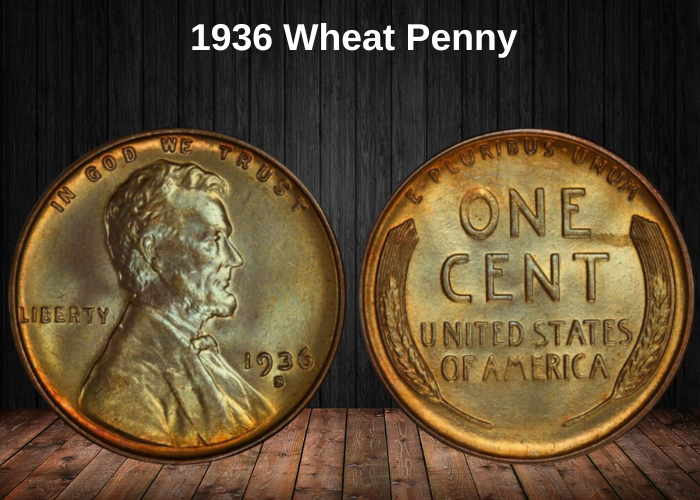
Wheat pennies like the 1936 edition belong to the Lincoln cent series, first introduced in 1909 to commemorate the 100th anniversary of Abraham Lincoln’s birth.
This release was a major milestone in American coinage history. For the first time, a real person’s portrait appeared on the obverse (front) of a U.S. coin. Prior to this, depicting an actual individual was frowned upon, as it felt too reminiscent of monarchies.
However, with growing admiration for Lincoln as his centennial approached, public sentiment shifted. The U.S. Mint decided to create a coin in his honor.
Victor David Brenner, a Lithuanian-American sculptor, was chosen to design the new penny. He started work in January 1909, and by July, the very first Lincoln cents were in circulation.
Over time, the reverse (back) design of the Lincoln cent changed multiple times. But the original wheat stalk design was still in use in 1936, which is why these coins are known as “Wheat Pennies.” The reverse shows two ears of durum wheat, symbolizing agricultural prosperity.
If you look closely at a 1936 penny, you’ll see Brenner’s initials (V.D.B.) on the front, right at the base of Lincoln’s shoulder.
Interestingly, the earliest 1909 Lincoln cents had those initials on the reverse. This sparked public outcry, with critics claiming the initials were too prominent and resembled self-promotion. As a result, production was briefly halted, and the initials were removed.
For nearly ten years, the coin featured no designer’s initials. Then in 1918, the Mint quietly restored them to their current spot on Lincoln’s shoulder.
The final Wheat Pennies were minted in 1958. The next year, to celebrate 150 years since Lincoln’s birth, a new reverse design was introduced—this time featuring the Lincoln Memorial in place of the iconic wheat ears.
Features of the 1936 Wheat Penny
The Obverse of the 1936 Penny
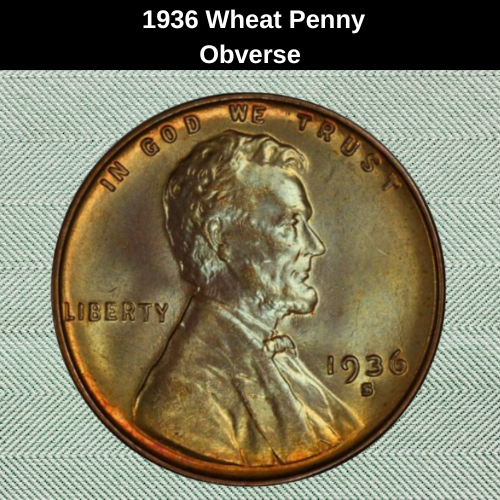
The front side (obverse) of the 1936 Wheat penny closely resembles that of today’s one-cent coins. It features the iconic portrait of Abraham Lincoln, which holds the record as the longest-used design on any U.S. coin.
Lincoln is depicted in side profile, facing right. The designer, Victor David Brenner, once mentioned that he imagined Lincoln reading to children when crafting the image, hoping to capture the president in a lively and relatable moment.
The phrase “IN GOD WE TRUST” appears in an arc above Lincoln’s head. To the left of the portrait is the word “LIBERTY”, and the year “1936” is found to the lower right of the coin.
If your penny has a small “D” or “S” beneath the date, it means it was minted in Denver or San Francisco, respectively. If there’s no mint mark, the coin was produced in Philadelphia, which didn’t use mint marks at the time.
The Reverse of the 1936 Wheat Penny
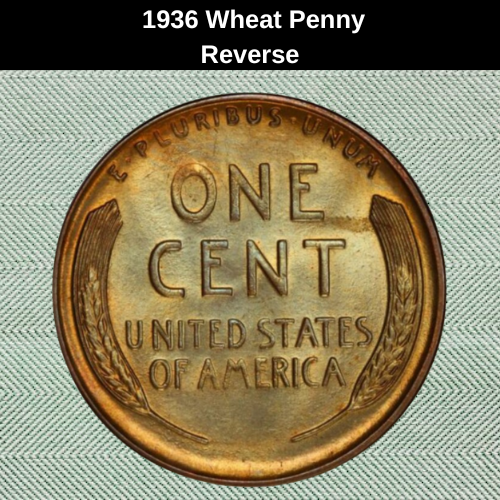
The reverse side of the 1936 Wheat penny was also crafted by Victor David Brenner, though it wasn’t his original design choice.
Brenner initially submitted a concept featuring a tree branch, but Mint officials rejected it, concerned that it too closely resembled contemporary French coins. He was asked to come up with something more distinctive and minimal—this led to the now-famous stylized wheat ears.
These wheat stalks arch upward along both the left and right edges of the coin, creating a natural border around the bold central inscription: “ONE CENT.” Just beneath that, in a smaller font, is the text “UNITED STATES OF AMERICA.”
Along the top rim, you’ll find the Latin phrase “E PLURIBUS UNUM,” which translates to “From the many, one.” This motto symbolizes the formation of the United States as a single nation from multiple individual states.
Other Features of the 1936 Wheat Penny
The 1936 Wheat penny was struck in bronze, composed of 95% copper and 5% tin and zinc. Thanks to its high copper content, the coin naturally changes color over time depending on how much it’s been handled or exposed to air.
When freshly minted, the coin has a vibrant reddish tone. But as it oxidizes, the surface darkens, turning brown. This transformation plays a major role in the coin’s value, as collectors place significant importance on its color classification.
Coins are typically sorted into three color categories: Red (RD), Red and Brown (RB), and Brown (BN). A penny must retain at least 95% of its original red color to be considered “Red.” Similarly, a coin is labeled “Brown” if 95% or more of its surface has turned that darker hue. Coins falling between those thresholds are given the Red and Brown designation.
As a rule of thumb, Red examples are the most desirable and valuable, followed by Red and Brown, with Brown specimens being the most affordable.
1936 Penny Grading
Understanding your coin’s grade is essential to determine its true value. Here’s a simplified breakdown of the grading system used by collectors and professionals:
| Grade | Description |
|---|---|
| 1 | Basal State-1 |
| 2 | Fair |
| 3 | Very Fair |
| 4, 5, 6 | Good |
| 7, 8, 10 | Very Good |
| 12, 15 | Fine |
| 20, 30 | Very Fine |
| 40 | Extremely Fine |
| 50 | About Uncirculated |
| 60 | Mint State (Uncirculated) |
| 65 | Choice Mint State |
| 70 | Perfect Mint State |
Before you can estimate the value of your coin, it’s essential to know its grade. We recommend using a reliable grading guide or having your coin professionally evaluated to ensure accuracy.
1936 Wheat Penny Value Guides
1936 No Mint Mark Wheat Penny Value
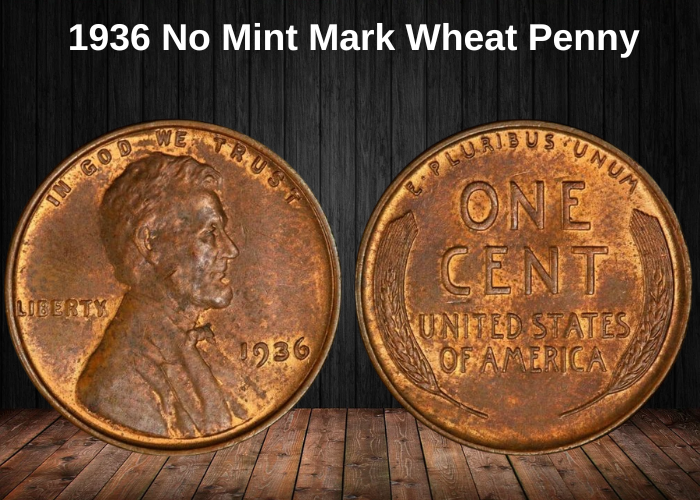
If your 1936 Wheat penny has no mint mark, it was one of the 310 million coins produced that year at the Philadelphia Mint.
In lower grades, especially those with a brown tone, these coins are typically worth just a few dollars. A coin with a red and brown appearance may fetch a bit more.
Coins with a full red color are usually in mint state, meaning they haven’t been in circulation and show very little to no wear. On the coin grading scale (which ranges from 1 to 70), mint state coins are graded MS60 and above.
A red 1936 Philadelphia penny graded MS60 is worth about $7, while one at MS65, the entry point for “gem” quality coins, is valued at around $26.
The best-known examples are four coins graded MS68 (full red), and according to PCGS, each is worth a staggering $17,750.
1936 D Wheat Penny Value

The Denver Mint produced over 40 million pennies in 1941. While brown coins from this mintage remain very common, red specimens are far more scarce, with only about 6,000 believed to still exist.
Due to their abundance, most circulated brown Denver pennies hold little more than face value, unless they feature a notable mint error.
In mint state, the values of Denver and Philadelphia pennies are mostly comparable. A red 1941-D penny graded MS60 is typically worth around $7.
However, at higher grades, Denver coins can fetch higher prices. A red Denver penny graded MS67 can be worth approximately $300, which is about $40 more than a Philadelphia coin of the same grade.
Interestingly, although the PCGS has certified only one red 1941-D penny at MS68, it is valued at $17,500—that’s nearly $3,000 less than a Philadelphia MS68 red penny.
1936 S Wheat Penny Value

The San Francisco Mint produced just over 29 million Wheat pennies in 1936, making the “S” mint mark the rarest of the three mint varieties from that year—in terms of mintage.
Despite this, brown pennies from San Francisco remain plentiful in circulated condition, and unless they feature a minting error, they typically aren’t worth more than face value.
On the other hand, red specimens hold more value, starting at around $8 in MS60. The highest known grade for this issue is MS67+, with examples at that level fetching as much as $5,750.
1936 (P) No Mint Mark Satin Proof Wheat Penny Value
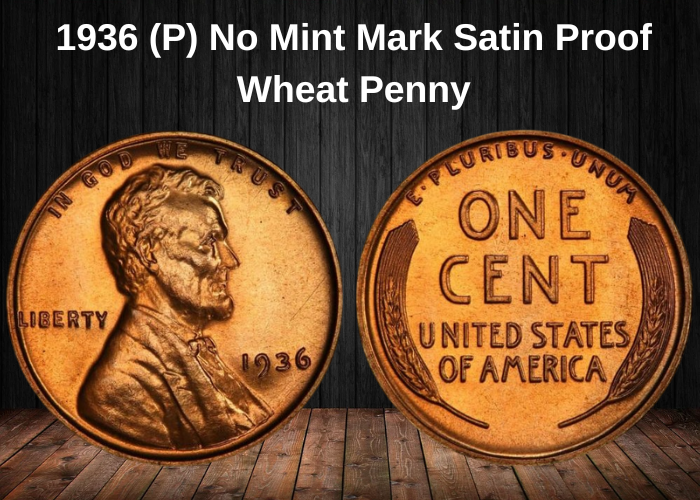
In addition to regular circulation strikes, the Philadelphia Mint also produced proof pennies in 1936 specifically for collectors. These came in two different finishes: satin and brilliant.
The satin proofs were the earliest to be struck and are now considered the rarest. The initial mintage was just over 5,500, but today, fewer than 600 are believed to have survived.
These coins follow the same color grading scale as business strikes—brown, red and brown, and red—but since they were never intended for circulation, the lowest grade assigned is PR60.
- A brown PR60 satin proof is worth about $215
- A red and brown one fetches around $275
- A red PR60 satin proof can be valued at $325
The finest known example is a red satin proof graded PR67, and it’s the only one of its kind. The PCGS estimates its value at an impressive $22,500.
1936 (P) No Mint Mark Brilliant Proof Wheat Penny Value
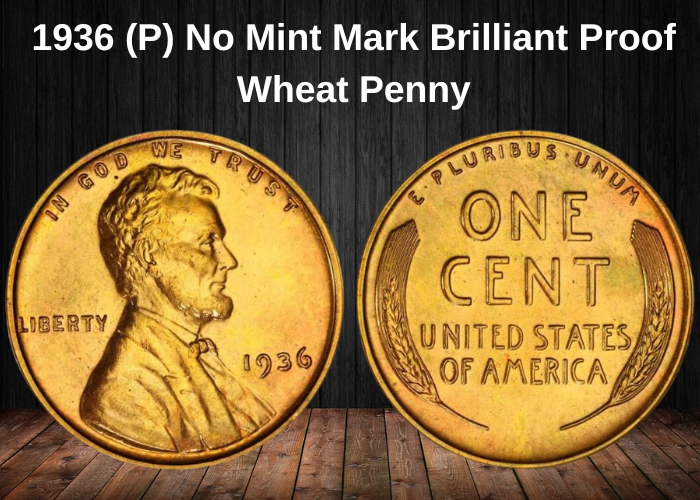
1936 proof pennies with a brilliant finish are also highly desirable among collectors. In addition to the usual three color classifications—brown, red and brown, and red—a very limited number of coins have received the “cameo” designation. These special coins display a striking contrast between mirror-like fields and frosted design elements.
- Brown brilliant proofs begin at about $200 for a PR60 example, and can reach up to $1,150 at PR66.
- Red and brown proofs range from $225 at PR60 to around $1,900 at PR66. (One coin has been certified PR67 by PCGS, but its value remains unlisted.)
- Red brilliant proofs are valued between $260 at PR60 and an impressive $23,500 at PR67.
If you’re looking for one of the few surviving cameos, prepare to spend at least $1,900 for a coin graded PR63. Their value climbs into five figures at PR65, and the most valuable example—a PR67 brilliant cameo—is currently worth an astonishing $50,000.
Rare 1936 Wheat Penny Errors List
1936 (P) Wheat Penny, Double Die Obverse, FS-101
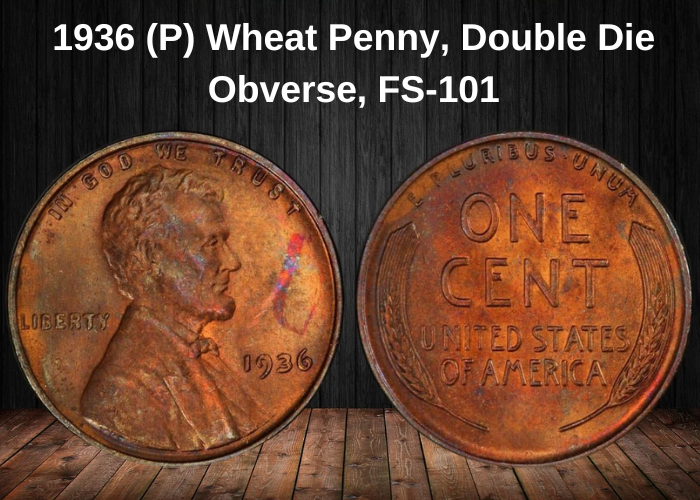
Designs are struck onto coins using a die. If there’s an error with the die, that error will be transferred to all the coins struck by that die.
For the 1936 Philadelphia Wheat pennies, three obverse dies had errors that caused doubling on the design. This doubling occurred due to movement during the manufacturing process. Each of these defective dies has a specific code.
- The double die obverse with the code FS-101 shows doubling on the date and the word “WE”.
The value of pennies with this error depends on their condition:
- An example graded XF45 is worth around $150.
- At MS63, the value rises to $1,500.
- For a red penny graded MS65, the value can reach up to $8,000.
Would you like to continue with more examples or other details on coin errors?
1936 (P) Wheat Penny, Double Die Obverse, FS-102
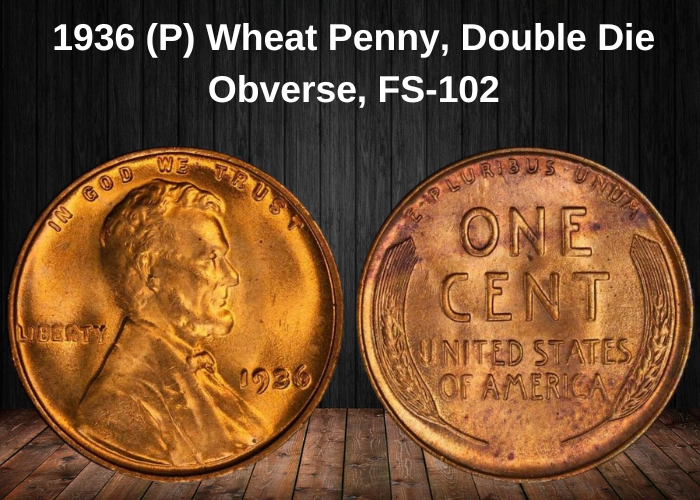
With the double die obverse coded FS-102, the doubling is most noticeable on the date. This error is slightly easier to find compared to FS-101, and consequently, its values are more modest.
The value of the FS-102 double die obverse depends on the condition of the coin:
- A coin graded XF45 is worth around $120.
- At MS63, the value rises to $300.
- For a red penny graded MS65, it can be worth around $1,000.
This YouTube video from Treasure Town showcases these errors, along with the third and most common double die obverse, coded FS-103.
Where to sell your penny?
Now that you know the value of your penny, you might be wondering where to sell it. Don’t worry: here’s a guide to some of the best online platforms where you can easily sell your coins, along with their advantages and disadvantages.
Discover the best platforms for selling coins online (pros and cons).
FAQs
1. What role does the 1936 Wheat Penny play in the context of U.S. coinage during the 1930s?
The 1936 Wheat Penny represents a time of economic recovery for the U.S. following the worst of the Great Depression. While the country was still in the process of rebuilding, coin production increased significantly, and the 1936 penny reflects the continuation of this recovery. The mintage figures were notably high, particularly from the Philadelphia and Denver mints, signaling a growing demand for currency and a stabilizing economy.
2. What makes the 1936 Wheat Penny from the San Francisco Mint (1936-S) particularly interesting?
The 1936-S Wheat Penny is interesting because it was minted in relatively smaller quantities (around 20.5 million coins), making it less common than its Philadelphia and Denver counterparts. Additionally, 1936-S coins are often found with lower-quality strikes, making high-grade examples—especially those graded MS65 RD and above—more valuable to collectors.
3. How does the mintage of the 1936 Wheat Penny compare to other years in the Wheat Cent series?
The total mintage for the 1936 Wheat Penny was about 316 million, making it one of the higher-mintage years. Despite the high numbers, high-quality uncirculated examples, especially those in MS66 RD and higher grades, are much rarer and more valuable. Most of the coins circulated widely, so finding well-preserved 1936 pennies can be challenging, especially when looking for those with strong strikes and minimal wear.
4. What is the value of the 1936 Wheat Penny in different grades, and which grade is the most desirable?
The 1936 Wheat Penny is fairly affordable in circulated grades:
- Good to VG (very good): $1–$3
- Fine to Very Fine: $3–$10
- Extremely Fine: $10–$30
However, uncirculated specimens in higher grades can be much more valuable:
- MS65 RD: Around $100–$150
- MS66 RD: Can range from $200–$300, depending on eye appeal and certification
The most desirable condition for investment and collection is MS66 RD, with well-struck examples fetching the highest prices.
5. Are there any known varieties or errors in the 1936 Wheat Penny series that increase collector interest?
While the 1936 Wheat Penny does not have major known varieties like the 1931-S No D or 1922 Weak D, collectors do seek out minor die cracks, off-center strikes, and re-punched mint marks (RPMs). Coins with unusual features, particularly when they come from rare mints like San Francisco (1936-S), are more valuable to error collectors.
6. How does the strike quality of the 1936 Wheat Penny affect its value?
The strike quality of the 1936 penny is crucial to its value, especially for coins with Red (RD) color. Coins from Philadelphia often exhibit good strike quality, but those from San Francisco (1936-S) are more likely to have soft strikes, particularly in areas like the wheat stalks and Lincoln’s hair. High-quality examples with sharp details and minimal contact marks from these mints are highly sought after and can command a premium in the market.
7. What makes the 1936 Wheat Penny a good coin for long-term investment?
The 1936 Wheat Penny offers investment potential due to its high mintage paired with its scarcity in uncirculated grades. With coins in MS65 RD or better being relatively scarce, demand from both set collectors and investors is expected to grow over time. Particularly for coins that are well-struck, have clean surfaces, and display full red luster, this penny has the potential to increase in value as the number of high-quality coins decreases and the demand for premium examples rises.



















































